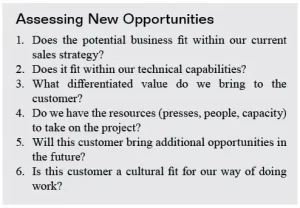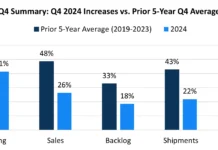by Nicole Mitchell, editor, Plastics Business
Manufacturing companies across the US are struggling to find the right new business opportunities for their teams – and those new opportunities have to be weighed against current capacity due to labor shortages, increased product cost, transportation issues and more. In the last two years, manufacturers have had to step back and discover new ways of successfully prospecting in the rubber and plastics industries.
Plastics Business interviewed two manufacturing professionals – Mark Hunt, vice president, global business at Engineered Sealed Products (ESP), Cedar Rapids, Iowa, and Tom Wood, vice president, sales at E-S Plastics, Milwaukee, Wisconsin – to discuss how their companies are navigating the tough environment.
ESP has been in the business for over 50 years, supplying elastomers and rubber seals to its customers, which are predominantly larger original equipment manufacturers (OEMs). The company is 100% employee-owned, with facilities across the US in Arlington, Texas; Kansas City, Missouri; and two facilities in Asia – Chennai, India, and Shenzhen, China.
E-S Plastics has over 100,000 sq. ft., 47 presses, 117 employees and $25,000,000 in molding revenue across its two facilities. The company’s account base includes agriculture, lawn and garden, refrigeration, water purification, generators and industrial manufacturing sectors. According to Wood, E-S Plastics’ sales team is comprised of four manufacturer representatives, with a balance cultivated and maintained internally as house accounts.
How is your company prospecting for new sales opportunities these days?
Wood: Reshoring is driving new opportunities. Also, dual sourcing / back-up tool opportunities are emerging. Many molders are evaluating their account base, and “noisy” customers are being asked to move their business. Customers who aren’t a good fit for an organization can take up a lot of resources, so exiting from noisy customers presents another form of new opportunities to evaluate. Sales opportunities are coming through networking channels within our region, the industry, our customer base and our supply base. Part of our success in networking is brought about by being in the business so long – it’s a process I’ve spent my whole career doing. It’s attending seminars, reading the trades, being in MAPP and other similar associations. Then, it’s knowing the toolmakers and suppliers. There comes a point when a potential customer will ask, “Who should I use for this part?” and people will say, “You should contact E-S Plastics.” Also, we (as many molders are) receive several unsolicited tool transfer RFQs per month.
Hunt: We put a lot of focus on our marketing initiatives to generate leads through our website, making sure we’re constantly keeping current with our product information. We also have some targeted account-based marketing campaigns that we employ in different areas, and we’ve used email marketing. We utilize outside firms from time to time to help with campaigns. But, we always lean on our business development managers, our internal employees, to try to cultivate new opportunities with the current customer base and keep their ears and eyes open for new prospects in their region.
What criteria do you use to determine if new opportunities fit into your business plan?
Wood: We like to diversify our account base when possible. We balance the sales volume and number of tools from the potential customer against limited internal resources, including product management, technical support, capacity and complexity of business. Space is another factor. We recently passed on quoting a bid on a 92-tool, million+-dollar tool transfer for these reasons. We also are looking at new business as a path to simplify our account base and possibly upgrade customers.
Hunt: They’ve got to be in alignment with our technical capabilities from a product offering standpoint. We consider ourselves problem solvers for our customers. So, if they’re having a problem or a performance quality issue with the current vendor, we’re going to first assess if we have something in our portfolio to solve the problem. If not, we may look at developing a solution if it fits within our engineering capabilities. But at the end of the day, if all those things don’t align, we have no trouble walking away because we want to do what’s best for the customer as well as for our company.
Walk me through your process of assessing an opportunity to see if it will fit.
 Wood: Our assessment process involves a review of the complexity of molding required, research related to the potential customer and then an analysis of press capacity.
Wood: Our assessment process involves a review of the complexity of molding required, research related to the potential customer and then an analysis of press capacity.
Hunt: Whenever an opportunity is presented by a customer, our sales team is expected to assess that opportunity and validate if it’s in alignment with our capabilities. We also talk a lot about differentiating value. We want to make sure we’re bringing value to a customer – something that sets us apart. If it turns out we don’t have that point of differentiation, then we may just be another quote for the customer, and we’re less likely to pursue those opportunities. We don’t have a software program we plug all this into that spits out an answer when we’re assessing new projects. Instead, it’s about training our sales team on our capabilities, and then training them on how to sell our differentiating value so that they’re fully equipped to assess these opportunities and make that determination. Once an opportunity is brought inside the company, then we have our cross-functional team of experts get involved, especially if there’s any design work. But our sales teams are always the first filter to assess if a project will be a good fit.
How do you balance the desire to bring in new business with the supply chain shortages and transportation issues? How are those two challenges affecting your workflows?
Wood: We are cautious when evaluating new business against the commitments we have for current customers. The key is to manage expectations and not overcommit to timelines when onboarding new business. When we do onboard the business, generally we want to make sure that we each are on the same page. One process we’ve implemented is to take on programs in phases. For example, phase one is three tools; phase two is five tools; and phase three is another set. It’s helped with not overcommitting. What levels the playing field is all of us have the same supply chain challenges. Our success has been found in transparency, with a commitment to communicate good and bad updates.
Hunt: We offer our customers a variety of solutions. We have a large supply base network across the world, and we also are pretty strong at finding alternatives if the current material or compounds are not available. We’re constantly assessing where we have bottlenecks and trying to find alternatives, tapping into our resources in Asia when needed. But I’d say, more recently, we’re seeing more and more customers having an interest in onshoring some of their product, just to mitigate risk of some of the global challenges we’ve faced over the last couple of years. It’s definitely impacting us just as it is with about every company out there, but we’re constantly looking for options, whether for supply chain issues or transportation issues. At one point, we were air freighting our parts to avoid delays with ocean shipments. We’ve had parts brought into our facility via truck as opposed to rail. So, we’re constantly looking at ways to address those bottlenecks. It’s all about communication and looking for alternatives to try to minimize the disruption to production lines.
What’s the biggest challenge for your sales team today?
Wood: Staying humble. We have had a great run since the pandemic changed our industry in 2020. Opportunities are abundant now, but we all need to remember this phase will pass. Then, we will be right back to the time-worn “beat down” of customer edicts, existing business being tensioned, internet bids, auctions and injection molders being played against each other.
Hunt: The biggest challenge is balancing the daily schedule. Our sales team is expected to focus on new business. But, given all the challenges we’ve faced over the last two or three years, they’ve had to get more involved in day-to-day issues: delivery challenges, pricing challenges and a variety of other things that would be handled by the customer service team in a perfect world. But in these kinds of markets, it’s all-hands-on deck to serve the customer at a high level. So, the sales team tends to wear a lot of different hats, and sometimes that means they don’t have as many hours in the day to focus on bringing that new business in.





